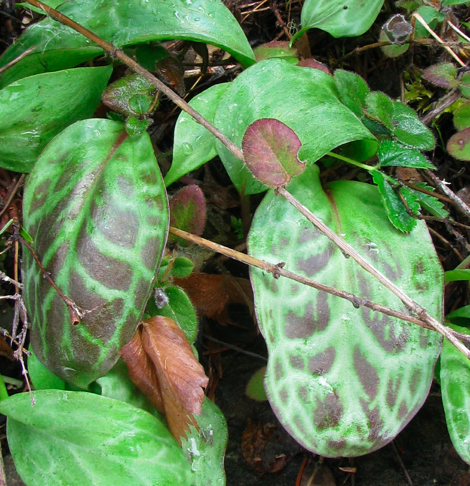Despite an unseasonable snowfall last week, two days later we found some uncommon wildflowers blooming on a sunny slope bordering a forest road.
We’d noted the leaves of these delphiniums (larkspurs) the week before, and now they were in full bloom

The majority were white, like these

but according to the experts only two white species (Delphinium leucophaeum and D. pavonaceum ) occur west of the Cascade Mountains, and neither are found south of the Williamette Valley (in northern Oregon). Their range may be restricted to the area of a temporary lake formed after one or more of the catastrophic Missoula Floods which occurred around 15,000 years ago, when glacier dams broke releasing huge quantities of water and silt, over parts of what’s now Oregon and Washington.
Delphinium menziesii occurs in our county, but it’s dark purple with a more finely divided leaf. Maybe the ones we saw are Delphinium andersonii, which does seem to have light blue to very pale almost white flowers, and a three-lobed leaf like the ones we saw.
An exciting find was this fritillary, a member of the lily family.

Wikipedia says that “fritillary” comes from the Latin term for a dice-box (fritillus), and probably refers to the checkered pattern, frequently of chocolate-brown and greenish yellow, that is common to many species’ flowers. (And there’s a group of butterflies so named for the same reason.) The checkered pattern is visible on both the bud and opened bloom above.

At least 3 species are found around here; this one is Fritillaria recurva, the Scarlet Fritillary. The nearby town of Jacksonville has a festival every year in honor of the rare species found near there, Fritillaria gentneri, which has darker red flowers. And we have a few times seen, on our own property, Fritillaria affinis or Chocolate lily, which has bell-shaped greenish flowers with brown markings. We don’t have any photos of it, but here’s one from USDA

Their account notes that the root bulbs are edible, though bitter, and were an item of trade for tribes in this area. F. affinis is quite variable in flower color, sometimes showing the reverse of the ones we’ve seen: purplish-brown flowers with green or yellow “dice”, as below.

We also saw two other wildflowers more familiar to us: shooting stars,

always one of the more abundant flowers this time of year,

and our beloved Trout Lilies (Erythronium hendersonii), delicate and demure plants with a very brief duration of bloom.

They range in color from nearly white to a darker violet-pink. Flowers are borne so close to the ground that it’s hard to get a look from underneath.

The mottled leaves are the reason for some of the common names—Trout Lily, Fawn Lily—and I think they are as beautiful as the flowers, in their way.



Need to know what flowers would be blooming on the eastern slope of Brown Mountain near Lake of the Woods in southeastern Oregon in late August.
Thanks!
Hello, My name is Michael and I have a pick of the Chocolate Lily my Wife and I took on Lower Table Rock. https://picasaweb.google.com/103885083360797188620/TableRock2008#5193752105249379506
Tell me what you think and reply if you like.
Great photo of the Chocolate Lily, Michael. We have yet to make it up Table Rock, my husband has a knee replacement that isn’t quite up to it yet. Looks like you all had a fun time up there.
Oh wow thanks for identifying all those plants. I have found them in my yard at my home in Rogue River in the Wards Creek area. I even have the scarlet frittilary! That was a real exciting find. The trout lilies and shooting stars all came if full bloom for Easter. I cant wait to see what else pops up over the summer
This Larkspur may be a white form of Delphinium nuttallianium. I’ve seen a white form similar to this in southern Oregon, as well as the more typical light blue and dark blue forms, often mixed together. The populations that I’d seen were along Star Gulch Road near the Applegate River (Mckee Bridge) in Jackson County, Oregon. I’ve vouchered specimens of that white Delphinium nuttallianium population at the Oregon State University Herbarium. I’ve seen other white Delphinium nuttallianium populations in the Columbia Gorge on the Washington State side. where did you see your white Delphinium ? I’d like to positively ID it (maybe visit the site) and add it to the list of known sites. Please get back to me if you can.
Dr. Northway,
Thanks for your information on these flowers. In fact, we were somewhere along Star Gulch Road ourselves. We live a mile away and often walk along there or on unpaved roads that branch off of it. So this would be the same population you’ve vouchered. Due to my husband’s health we haven’t been walking much but I still go up there once a week or so with our dog, & can try to find and photograph them again when the time comes. Would good close-ups of flower and leaf enable you to identify them, or do you need a dissected view of the flower? (Neither of us knows how to key out a plant, we just use Turner & Gustafson and other books, and try to verify online on reliable sites.)
I even have the scarlet frittilary! That was a real exciting find. vong hoa tang
Hi there, do you know of a decent wildflower identifying guide for Jackson County? I bought one on Amazon & it’s not at all suitable for this area. Please email if you know of one.
Thank you!